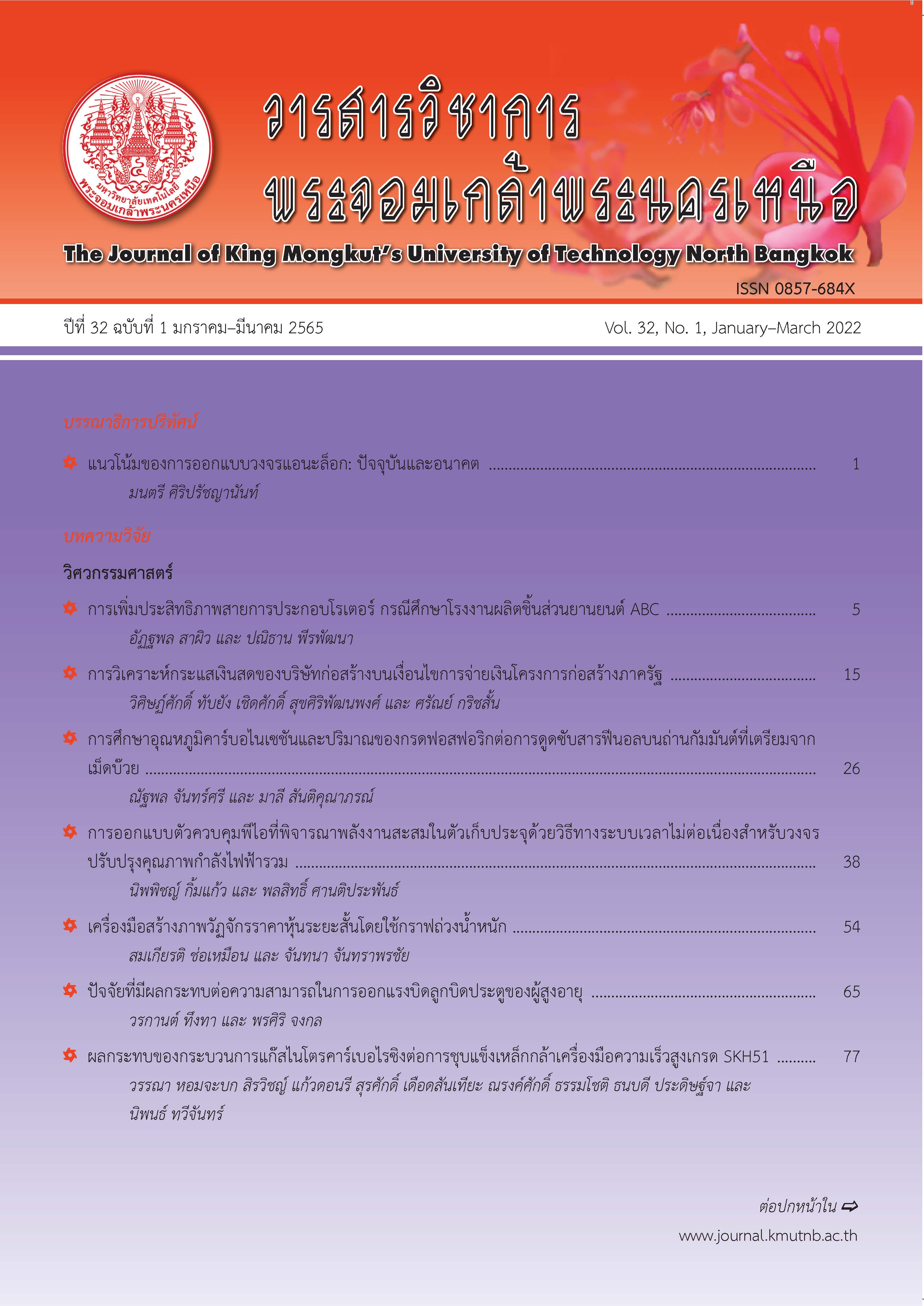การศึกษาอุณหภูมิคาร์บอไนเซชันและปริมาณของกรดฟอสฟอริกต่อการดูดซับสารฟีนอลบนถ่านกัมมันต์ที่เตรียมจากเม็ดบ๊วย
Main Article Content
บทคัดย่อ
ถ่านกัมมันต์ที่เตรียมจากเม็ดบ๊วยด้วยสารละลายกรดฟอสฟอริก ซึ่งใช้เป็นสารในการปรับสภาพผิวได้ถูกประเมินความสามารถในการดูดซับสารฟีนอลในระบบแบบกะที่ค่าพีเอช และความเข้มข้นเริ่มต้นแตกต่างกัน ในงานวิจัยนี้นำสองพารามิเตอร์มาพิจารณาคือ อุณหภูมิในการคาร์บอไนเซชัน (400, 500 และ 600 องศาเซลเซียส) และอัตราส่วนระหว่างปริมาณเม็ดบ๊วยกับปริมาณกรด (1 : 1.0, 1 : 1.5 และ 1 : 2.0) ผลการศึกษาแสดงให้เห็นว่า อุณหภูมิในการคาร์บอไนเซชันและอัตราส่วนระหว่างปริมาณเม็ดบ๊วยกับปริมาณกรดมีบทบาทสำคัญต่อสมบัติของถ่านกัมมันต์ที่เตรียมขึ้น ถ่านกัมมันต์ที่ถูกคาร์บอไนซ์ที่ 500 องศาเซลเซียส มีค่าไอโอดีนนัมเบอร์ ค่าการดูดซับเมทิลีนบลู และมีประสิทธิภาพในการดูดซับสารฟีนอลสูง โดยเฉพาะ AC500,2.0 ในขณะที่ถ่านกัมมันต์ที่ถูกคาร์บอไนซ์ที่ 600 องศาเซลเซียส ให้ค่าไอโอดีนนัมเบอร์ และค่าการดูดซับเมทิลีนบลูต่ำที่สุดในทุกอัตราส่วน สำหรับการศึกษาการดูดซับสารฟีนอลนั้น การดูดซับสามารถถูกอธิบายด้วยแบบจำลองจลนพลศาสตร์อันดับสองเทียมได้เป็นอย่างดี โดยมีค่า R2 เท่ากับ 0.99 นอกจากนี้ ค่าการดูดซับที่สมดุลเป็นไปตามไอโซเทอมแบบแลงเมียร์ ยกเว้น AC600,2.0
Article Details
บทความที่ลงตีพิมพ์เป็นข้อคิดเห็นของผู้เขียนเท่านั้น
ผู้เขียนจะต้องเป็นผู้รับผิดชอบต่อผลทางกฎหมายใดๆ ที่อาจเกิดขึ้นจากบทความนั้น
เอกสารอ้างอิง
[2] Wikipedia. (2020, May). Activated carbon. [Online]. Available: https://en.wikipedia.org/wiki/Activated_carbon
[3] K. S. Ukanwa, K. Patchigolla, R. Sakrabani, E. Anthony, and S. Mandavgane, “A review of chemicals to produce activated carbon from agricultural waste biomass,” Sustainability, vol. 11, pp. 6204–6239, 2019.
[4] H. Hadoun, Z. Sadaoui, N. Souami, D. Sahel, and I. Toumert, “Characterization of mesoporous carbon prepared from date stems by H3PO4 chemical activation,” Applied Surface Science, vol. 280, pp. 1–7, 2013.
[5] W. C. Lim, C. Srinivasakannan, and N. Balasubramanian, “Activation of palm shells by phosphoric acid impregnation for high yielding activated carbon,” Journal of Analytical and Applied Pyrolysis, vol. 88, pp. 181–186, 2010.
[6] S. Chakraborty, S. De, S. DasGupta, J. K. Basu, “Adsorption study for the removal of basic dye: Experimental and modeling,” Chemosphere, vol. 58, pp. 1079–1086, 2005.
[7] M. J. Martin, A. Artola, M. D. Balaguer, and M. Rigola, “Activated carbons developed from surplus sewage sludge for the removal of dyes from dilute aqueous solutions,” Chemical Engineering Journal, vol. 94, no. 3, pp. 231–239, 2003.
[8] R. Bansode, J. N. Losso, W. E. Marshall, R. M. Rao, and R. J. Portier, “Adsorption of volatile organic compounds by pecan shell- and almond shell-based granular activated carbons,” Bioresource Technology, vol. 90, no. 2, pp. 175–184, 2003.
[9] S. Mopoung, P. Moonsri, W. Palas, and S. Khumpai, “Characterization and properties of activated carbon prepared from tamarind seeds by KOH activation for Fe(III) adsorption from aqueous solution,” The Scientific World Journal, vol. 2015, pp. 1–5, 2015.
[10] S. Rattanapan, P. Pengjam, and P. Kongsune, “Preparation and characterization of mangosteen peel activated carbon,” Thaksin University Journal, vol. 17, no. 3, 2014 (in Thai).
[11] K. Sanprasert, “Phenol,” in The Treatment of Chemical Poisoning 1, 1st ed. Bangkok: We Plus Group (Thailand), 2016 (in Thai).
[12] Ministry of Industry, “Specify criteria for soil and groundwater contamination,” Ministry of Industry, Bangkok, Thailand, 2016.
[13] Standard Test Method for Determination of Iodine Number of Activated Carbon, ASTM D4607-14, 2014.
[14] N. Petrov, T. Budinova, M. Razvigorova, and V. Minkova, “Preparation of activated carbons from cherry stones, apricot stones and grape seeds for removal of metal ions from water,” in Proceedings 2nd Olle Indstorm Symposium on Renewable Energy-Bioenergy, Stockholm, Sweden, 1999, pp. 46–50.
[15] V. Daptardar, D. Koti, and D. Rajmohan, “Adsorption of BTX vapors on activated carbon pellets prepared from waste cashew nut shell,” JEST-M, vol. 4, no. 4, pp. 25–29, 2015.
[16] A. T. Mohd Din, B. H. Hameed, and A. L. Ahmad, “Batch adsorption of phenol onto physiochemical-activated coconut shell,” Journal of Hazardous Materials, vol. 161, no. 2–3, pp. 1522–1529, 2009.
[17] D. H. Everett, “Manual of symbols and terminology for physicochemical quantities and units, appendix II: Definitions, terminology and symbols in colloid and surface chemistry,” Pure and Applied Chemistry, vol. 31, pp. 577–638, 1972.
[18] B. Xie, J. Qin, S. Wang, X. Li, H. Sun, and W. Chen, “Adsorption of phenol on commercial activated carbons: Modelling and interpretation,” International Journal of Environmental Research and Public Health, vol. 17, no. 3, pp. 789, 2020.
[19] B. H. Hameed and A. A. Rahman, “Removal of phenol from aqueous solutions by adsorption onto activated carbon prepared from biomass material,” Journal of Hazardous Materials, vol. 160, no. 2–3, pp. 576–581, 2008.
[20] M. Ahmaruzzaman and D. K. Sharma, “Adsorption of phenols from wastewater,” Journal of Colloid and Interface Science, vol. 287, no. 1, pp. 14–24, 2005.

